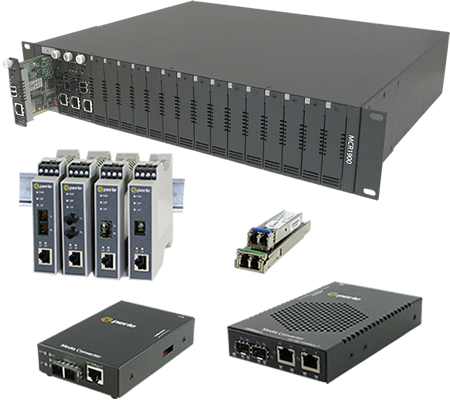
Alles, was Sie über LWL-Medienkonverter wissen müssen
Von Julie McDanielVice President Marketing
7. April 2025
LWL-Medienkonverter sind Netzwerkgeräte, die zwei verschiedene Medientypen verbinden können. In den meisten Fällen werden sie verwendet, um Twisted-Pair- oder Koaxialkabel mit einem Glasfaserkabel zu verbinden und so die Zusammenschaltung von Glasfasernetzen und Kabelsystemen mit kupferbasierten Verkabelungssystemen zu ermöglichen. Dadurch kann die Netzinfrastruktur teilweise auf Glasfasertechnologie umgestellt werden, die Anschlussfähigkeit an Kupfer- und andere kabelgebundene Netze bleibt erhalten und die Ethernet-Geschwindigkeit wird erhöht.
LWL vs. Kupfer
Gewöhnliche Kupferkabel weisen bei größeren Längen erhebliche Verluste auf – bei 100 Metern endet die Übertragbarkeit. Zur Verstärkung des Signals müssen Repeater installiert werden. Der Anschluss von Kupferkabeln an ein Glasfaserkabel mit Hilfe eines LWL-Medienkonverters kann die Übertragungsqualität verbessern, da Glasfaser im Gegensatz zu Kupfer eine größere Reichweite bietet. LWL-Medienkonverter können auch lokale Netze erweitern und miteinander verbinden und so ein größeres verbundenes Netz schaffen.
Die Lösung für Kompatibilitätsprobleme
LWL-Medienkonverter unterstützen mehrere Kabeltypen, z. B.
- Koaxial
- Twisted-Pair
- Single- oder Multi-Modem-Glasfaserkabel
Damit können Sie eine Verbindung zu den meisten Datenkommunikationsprotokollen herstellen und diese nutzen, darunter:
- Ethernet und Fast Ethernet
- Gigabit und 10G Ethernet
- SDI, Video und Fibre Channel
- ATM/SONET OC-X, SDH STM-X und FDDI
Die Palette an LWL-Medienkonvertern reicht von Standalone-Geräten mit geringem Platzbedarf – perfekt für einen Schrank oder Telekommunikationsschrank in einer kleineren IT-Abteilung – bis hin zu rechenzentrumstauglichen Gehäusesystemen mit hoher Portdichte und erweiterten Netzwerkverwaltungsfunktionen.
Arten von LWL-Medienkonvertern

Mit Kupfer-LWL-Konvertern können Sie kupferverdrahtete Systeme an Glasfasersysteme anschließen und so in der Regel die Übertragung aus und in ein Gebäude oder Netzwerk beschleunigen. Sie können auch LWL-zu-LWL-Konverter haben für den Fall, dass Sie zwei Netze miteinander verbinden wollen, oder LWL zu seriell verbinden, um eine bessere Portierung zu erreichen.
Sie können mehrere LWL-Medienkonverter verwenden, um unter Verwendung von verwalteten oder nicht verwalteten Lösungen mehrere LANs zu einem großen zusammenhängenden Netzwerk zu kombinieren. Unverwaltete Konverter sind reine Plug-and-Play-Geräte, während verwaltete Konverter in bestehende Netzwerksicherheitsdienste integriert werden und Ihnen die Kontrolle über Aspekte wie die Priorisierung des Datenverkehrs und die Zuweisung von Bandbreite ermöglichen.
Industrielle Medienkonverter verfügen über zusätzliche Zertifizierungen und gehärtete Komponenten für den Einsatz unter rauen Betriebsbedingungen, z. B. in der Fertigung, der Abwasseraufbereitung, der Verkehrssteuerung, in Umspannwerken von Stromversorgern und in der Fabrikautomation.
Power-over-Ethernet- oder PoE-Medienkonverter bieten eine verlängerte Distanz über Glasfaser für PoE-betriebene Geräte sowie Stromversorgung über dasselbe interne Kupferkabel, das für Daten verwendet wird. Zu den Geräten, die über PoE mit Strom versorgt werden können, gehören:
- Überwachungskameras
- IP-Telefone und Videokonferenzanlagen
- WLAN-Geräte
PoE kann auch Überwachungskameras und Wireless Access Points, die sich in unzugänglichen Bereichen befinden, mit dem Netzwerk-Backbone verbinden.
Vorteile von LWL-Medienkonvertern
LWL-Medienkonverter bieten eine bequeme und kosteneffektive Plug-and-Play-Lösung, die die „Kupfer zu Glasfaser“-Herausforderung bewältigt. Sie werden in allen Branchen und Sektoren eingesetzt, z. B. in Campus-LANs, Unternehmen, Rechenzentren, bei der Sicherheitsüberwachung und im Verteidigungsbereich, um Verbindungen zwischen Kupfer und Glasfaser herzustellen.
Eine vollständige Umstellung der Netzwerkkabel von Kupfer auf Glasfaser ist technisch schwierig und kann hohe Investitionskosten (CapEx) verursachen. Die meisten Installationen haben einen großen Bestand an Kupferkabeln und nutzen Kupferanschlüsse, sodass eine Umstellung auf Glasfaser unpraktisch und teuer wäre. Der Einsatz von LWL-Medienkonvertern löst das Problem dank der geringen Investitionskosten und kann die Übertragungsqualität erheblich verbessern.
Perle bietet eine breite Palette von Medienkonvertern für jede Anwendung und jedes Einsatzgebiet. Sie sind mit Cisco-Switches und -Routern kompatibel und verwenden High-End-Komponenten von führenden Chip-Herstellern, um die Zuverlässigkeit der Produkte zu gewährleisten. Wenn Sie mehr über unsere Medienkonverterlösungen erfahren möchten, kontaktieren Sie uns noch heute.



